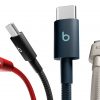2x Reduction of Nanometer Recording Technology Shows Promise for 1TB Notebook and 4TB Desktop PCs in 2011
Hitachi, Ltd. (NYSE:HIT) (TOKYO:6501) and Hitachi Global Storage Technologies (Hitachi GST) announced today they have developed the world’s smallest read-head technology for hard disk drives, which is expected to quadruple current storage capacity limits to four terabytes (TB) on a desktop hard drive and one TB on a notebook hard drive.
Researchers at Hitachi have successfully reduced existing recording heads by more than a factor of two to achieve new heads in the 30-50 nanometer (nm) range, which is up to 2,000 times smaller than the width of an average human hair (approx. 70-100 microns). Called current perpendicular-to-the-plane giant magnetoresistive(1) (CPP-GMR) heads, Hitachi’s new technology is expected to be implemented in shipping products in 2009 and reach its full potential in 2011.
Hitachi will present these achievements at the 8th Perpendicular Magnetic Recording Conference (PMRC 2007) to be held October 15-17, 2007 at the Tokyo International Forum in Japan.
“Hitachi continues to invest in deep research for the advancement of hard disk drives as we believe there is no other technology capable of providing the hard drive’s high-capacity, low-cost value for the foreseeable future,” said Hiroaki Odawara, Research Director, Storage Technology Research Center, Central Research Laboratory, Hitachi, Ltd. “This is an achievement for consumers as much as it is for Hitachi. It allows Hitachi to fuel the growth of the ‘Terabyte Era’ of storage, which we started, and gives consumers virtually limitless ability for storing their digital content.”
Hitachi believes CPP-GMR heads will enable hard disk drive (HDD) recording densities of 500 gigabits per square inch (Gb/sq. in.) to one terabit per square inch (Tb/sq. in.), a quadrupling of today’s highest areal densities. Earlier this year, Hitachi GST delivered the industry’s first one-terabyte hard drive at 148 Gb/; the company’s highest areal density shipping in products today is in the 200 Gb/ range. These products use existing head technology, called TMR(2) (tunnel-magnetoresistive) heads. The recording head and media are the two key technologies controlling the miniaturization evolution and the exponential capacity growth of the HDD.
Cutting Through the Noise – The Strongest Signal-to-Noise Ratio
The continued advancements of HDDs requires the ability to squeeze more, and thus, smaller data bits onto the recording media, necessitating the continued miniaturization of the recording heads to read those bits. However, as the head becomes smaller, electrical resistance increases, which, in turn, also increases the noise output and compromises the head’s ability to correctly read the data signal.
High signal output and low noise is what is desired in hard drive read operations; thus, researchers try to achieve a high signal-to-noise (S/N) ratio in developing effective read-head technology. Using TMR head technology, researchers predict that accurate read operations would not be conducted with confidence as recording densities begin to surpass 500 Gb/sq. in.
The CPP-GMR device, compared to the TMR device, exhibits less of an electrical resistance, resulting in lower electrical noise but also a smaller output signal. Therefore, issues such as producing a high output signal while maintaining a reduced noise to increase the S/N ratio needed to be resolved before the CPP-GMR technology became practical.
In response to this challenge, Hitachi, Ltd. and Hitachi GST have co-developed high-output technology and noise-reduction technology for the CPP-GMR head. A high electron-spin-scattering magnetic film material was used in the CPP-GMR layer to increase the signal output from the head, and new technology for damage-free fine patterning and noise suppression was developed. As a result, the signal-to-noise ratio, an important factor in determining the performance of a head, was drastically improved. For heads with track widths of 30nm to 50nm, industry-leading S/N ratios of 30 decibels (dB) and 40 dB, respectively, were recently achieved with the heads co-developed at Hitachi GST’s San Jose Research Center and Hitachi, Ltd.’s Central Research Laboratory in Japan.
Recording heads with 50nm track widths are expected to debut in commercial products in 2009, and those with 30nm track widths will be implemented in products in 2011. Current TMR heads, shipping in products today, have track widths of 70nm.
The Incredible Shrinking Head
The discovery of the GMR effect occurred in 1988, and that body of work was recognized just last week with a Nobel Prize for physics. Nearly two decades after its discovery, the effects of GMR technology are felt more strongly than ever with Hitachi’s demonstration of the CPP-GMR head today.
In 1997, nine years after the initial discovery of GMR technology, IBM implemented the industry’s first GMR heads in the Deskstar 16GXP. GMR heads allowed the HDD industry to continue its capacity growth and enabled the fastest growth period in history, when capacity doubled every year in the early 2000s. Today, although areal density growth has slowed, advancements to recording head technology, along with other HDD innovations, are enabling HDD capacity to double every two years.
In the past 51 years of the HDD industry, recording head technology has seen monumental decreases in size as areal density and storage capacity achieved dizzying heights. The first HDD recording head, called the inductive head, debuted in 1956 in the RAMAC – the very first hard drive – with a track width of 1/20th of an inch, or 1.2 million nm. Today, the CPP-GMR head, with a track width of about one-millionth of an inch, or 30nm, represents a size reduction by a factor of 40,000 over the inductive head used in the RAMAC in 1956.
Notes
(1) CPP-GMR: As an alternative to existing TMR heads, CPP-GMR head technology has a lower electrical resistance level, due to its reliance on metallic rather than tunneling conductance, and is thus suited to high-speed operation and scaling to small dimensions.
(2) TMR head: Tunnel Magneto-Resistance head
A tunnel magneto-resistance device is composed of a three layer structure of an insulating film sandwiched between ferromagnetic films. The change in current resistance which occurs when the magnetization direction of the upper and lower ferromagnetic layers change (parallel or anti parallel) is known as the TMR effect, and ratio of electrical resistance between the two states is known as the magneto-resistance ratio.
About Hitachi, Ltd.
Hitachi, Ltd., (NYSE:HIT) (TOKYO:6501), headquartered in Tokyo, Japan, is a leading global electronics company with approximately 384,000 employees worldwide. Fiscal 2006 (ended 31st March 2007) consolidated revenues totaled 10,247 billion yen ($86.8 billion). The company offers a wide range of systems, products and services in market sectors including information systems, electronic devices, power and industrial systems, consumer products, materials and financial services. For more information on Hitachi, please visit the company’s website at http://www.hitachi.com.
About Hitachi Global Storage Technologies
Hitachi Global Storage Technologies develops advanced hard disk drives to store and preserve the world’s valued data. Founded by the pioneers of hard drives, Hitachi GST enables users to fully engage in the digital lifestyle by providing high-value, high-capacity storage in formats suitable for the office, in the home or on the road. With vertically-integrated research, design and manufacturing capabilities, Hitachi GST delivers leadership technology and quality to its global customer base.
With approximately 33,000 employees worldwide, Hitachi GST offers a comprehensive range of hard drive products for desktop computers, high-performance storage systems and servers, notebooks and consumer devices. For more information, please visit the company’s website at http://www.hitachigst.com.























